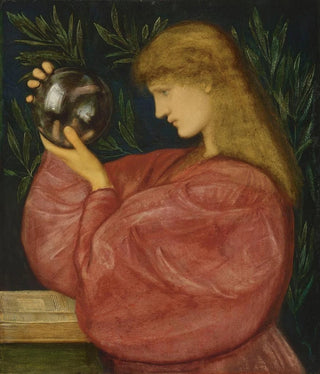Art print | Astrology - Sir Edward Coley Burne-Jones


View from behind

Frame (optional)
Astrology - Sir Edward Coley Burne-Jones – Captivating Introduction
In the enchanting world of art, certain works manage to capture the imagination and transcend time. "Astrology" by Sir Edward Coley Burne-Jones is a shining example. This piece, which evokes humanity's fascination with the stars and the mysteries of the universe, immerses us in a universe where science and magic meet. Through this artwork, Burne-Jones invites us to explore themes of knowledge and intuition, while offering a poetic vision of astrology, a millennia-old discipline that continues to intrigue and inspire. Contemplating this art print, the viewer is transported on a mystical journey, where each star tells a story and each constellation reveals a secret.
Style and uniqueness of the work
The work "Astrology" stands out for its Pre-Raphaelite style, characterized by meticulous attention to detail and a palette of rich, vibrant colors. Burne-Jones, master of Victorian aesthetics, uses flowing forms and delicate lines to create an atmosphere of dream and contemplation. The human figures, often idealized, seem to dance within a starry cosmos, embodying both beauty and fragility of existence. The composition, skillfully orchestrated, guides the viewer’s gaze through a celestial landscape filled with esoteric symbols. Every element of the artwork, whether constellations, planets, or mythological characters, is charged with deep meanings that invite reflection and personal interpretation. This stylistic singularity makes "Astrology" a timeless work, capable of touching hearts and awakening minds.
The artist and his influence
Sir Edward Coley Burne-Jones, an emblematic figure of the Pre-Raphaelite movement, left his mark on his era with his unique artistic vision and passion for mythological stories. Influenced by the writings of Dante and medieval legends, he developed a style that combines romanticism and mysticism, creating works of great emotional depth. His work also served as a bridge between the 19th century and the

Matte finish

View from behind

Frame (optional)
Astrology - Sir Edward Coley Burne-Jones – Captivating Introduction
In the enchanting world of art, certain works manage to capture the imagination and transcend time. "Astrology" by Sir Edward Coley Burne-Jones is a shining example. This piece, which evokes humanity's fascination with the stars and the mysteries of the universe, immerses us in a universe where science and magic meet. Through this artwork, Burne-Jones invites us to explore themes of knowledge and intuition, while offering a poetic vision of astrology, a millennia-old discipline that continues to intrigue and inspire. Contemplating this art print, the viewer is transported on a mystical journey, where each star tells a story and each constellation reveals a secret.
Style and uniqueness of the work
The work "Astrology" stands out for its Pre-Raphaelite style, characterized by meticulous attention to detail and a palette of rich, vibrant colors. Burne-Jones, master of Victorian aesthetics, uses flowing forms and delicate lines to create an atmosphere of dream and contemplation. The human figures, often idealized, seem to dance within a starry cosmos, embodying both beauty and fragility of existence. The composition, skillfully orchestrated, guides the viewer’s gaze through a celestial landscape filled with esoteric symbols. Every element of the artwork, whether constellations, planets, or mythological characters, is charged with deep meanings that invite reflection and personal interpretation. This stylistic singularity makes "Astrology" a timeless work, capable of touching hearts and awakening minds.
The artist and his influence
Sir Edward Coley Burne-Jones, an emblematic figure of the Pre-Raphaelite movement, left his mark on his era with his unique artistic vision and passion for mythological stories. Influenced by the writings of Dante and medieval legends, he developed a style that combines romanticism and mysticism, creating works of great emotional depth. His work also served as a bridge between the 19th century and the






